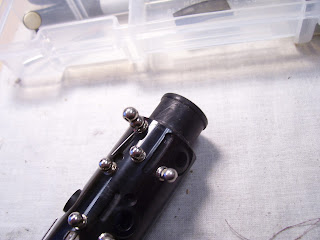 |
| My worksheet with all of my calculations. Also the stem I was replicating |
 |
| Turning the end for the male threads |
 |
| Using the 10-32 die to make the threads |
 |
| Drilling the hole for the inner threads |
 |
| My worksheet with all of my calculations. Also the stem I was replicating |
 |
| Turning the end for the male threads |
 |
| Using the 10-32 die to make the threads |
 |
| Drilling the hole for the inner threads |
 |
| Old tenon cork |
 |
| Cleaned tenon and ready for corking |
 |
| Strip of cork cut for the tenon |
 |
| Bevel on the end of the cork |
 |
| Bump created where the cork overlaps |
 |
| Sanding the cork to the correct size so the tenons will fit together |
 |
| Sealing the cork with paraffin wax |
 |
| Heating the glue to put in the pad cup |
 |
| Heating the pad cup with glue in it so that it is ready for the pad |
 |
| Swedging collet tool. There are different size collets for different sized hinge tubes |
 |
| My clarinet screw board showing the different hinge rods and pivot screws |